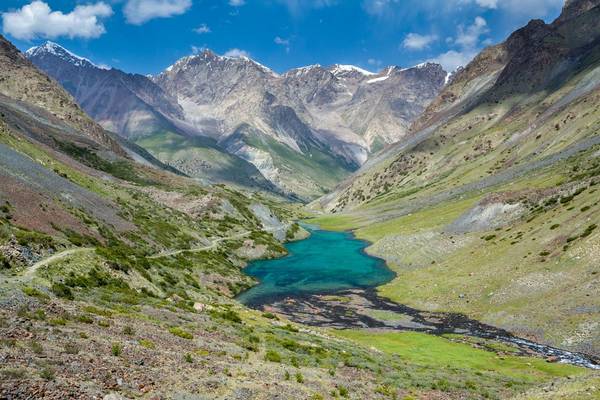Wildlife Holidays in Central Asia




Central Asia is a fascinating, endlessly beautiful and underexplored region. Once the beating heart of the great Silk Road that connected Western and Eastern civilisation, today it goes largely unnoticed by international travellers. Often referred to collectively as “the Stans”, these countries’ status as former Soviet outposts perhaps conjures up images of sterile, concrete metropoles and vast, lifeless industrial farmlands. The reality could not be more different – Central Asia boasts diverse and achingly gorgeous landscapes, from the frosted peaks of the Tien Shan Mountains, through lush juniper forests and tulip-adorned alpine meadows to rich wetlands and stony lowland deserts. Naturally, this variety of habitats is matched by an overwhelming assemblage of wildlife, much of it astonishingly distinctive and abundant. Furthermore, although the region is sparsely populated, meaning that visitors can have whole vistas to themselves, its cities are rich in history and culture, replete with gaudy, riotous architecture from the days when this was the centre of the known world. Far from a bland backwater, Central Asia is in fact a destination brimming with potential.
Speak with our Central Asia specialist

Our Specialist Recommends
'Our "Birds of Kazakhstan & Kyrgyzstan" holiday offers unforgettable wildlife-watching, starting in the mountains near Almaty, where we can encounter Blue Whistling Thrush, Azure Tit and Meadow Bunting. The dry steppes and escarpments of Charyn National Park, with its famous gorge, hosts Pallas’s Sandgrouse, Asian Desert Warbler, Pied Wheatear, Grey-necked Buntings and Siberian Ibex. We next cross into charming Kyrgyzstan to marvel at the high Tien Shan Mountains, home to Himalayan Snowcock, Güldenstädt’s Redstart, Himalayan Rubythroat and Ibisbill. Crossing back into Kazakhstan, the steppes and semi-deserts northwest of Almaty feature Macqueen’s Bustard, Greater Sand Plover and Turkmen Gazelle. Turunga woodland, and Saxaul scrub near Lake Balqash, provides opportunity to search for Yellow-eyed Pigeon, White-winged Woodpecker, Turkestan Tit, and Saxaul Sparrow. Raptors such as Shikra, Oriental Honey Buzzard, and more than five species of eagle, are a mouth-watering possibility across the tour.'
Operations Manager - Dan LayWildlife of Central Asia
The heart of Central Asia is the nation of Kazakhstan, which, at nearly three million square kilometres, is on its own as large as the whole of Western Europe. With a population of only around 20 million people, mostly in its cities, Kazakhstan is home to vast, open and unpeopled spaces, from stone-and-sand deserts through close-cropped steppes to inland seas and waterways. Most dramatic of all, however, are the mighty mountains of the Tien Shan – a great 1,000-mile-long limb reaching north from the Himalaya. These peaks dominate the country’s geography, giving with one hand and taking with another; waters flowing downslope feed lakes and inland deltas, while their rain shadow withholds moisture from barren deserts.
The mountains themselves support a wonderful diversity of habitats and species. They are, in particular, a paradise for botanists, with a wide variety of primulas, tulips and saxifrages, plus several beautiful endemic trees, to be found amongst thousands of recorded species. On the highest peaks live the true mountain specialists, including birds such as Himalayan Snowcock, Brown and Altai Accentors, Golden Eagle, Wallcreeper, Alpine Chough and Güldenstädt’s Redstart. Iconic wilderness mammals also patrol the heady, inaccessible reaches of the Tien Shan: Brown Bear, Grey Wolf and even the ghostly Snow Leopard. More likely to be seen are species such as Siberian Ibex and Marco Polo sheep.
At slightly lower altitudes, amidst a twisted maze of breathtaking passes and gorges, is a landscape of flower-filled alpine meadows, lush montane spruce forests and dense juniper scrub. In spring, open areas are tapestried with the blooming of red, yellow and orange tulip flowers – Central Asia boasts some of the planet’s most spectacular floral displays. No less mouth-watering is the variety of birdlife on show: Brown Dipper, Himalayan Griffon Vulture, Black-throated Accentor, Himalayan Rubythroat, White-winged Grosbeak, Hodgson’s Mountain Finch, White-browed Tit-warbler and Eversmann’s Redstart, amongst so many more. Montane lakes additionally support breeding Ibisbill, a peculiar and highly sought-after species of wading bird that has no close relatives.
From the great peaks of the Tien Shan, water cascades down the mountainsides to support life in the lowlands. Nowhere is this more evident than at the Charyn River Gorge, a series of magnificent red, yellow and black canyons surrounded by cliffs and meadows. In these areas can be found Egyptian Vulture, Long-legged Buzzard, Saker Falcon, Mongolian Finch and Pine Bunting. From here, the Charyn River continues to thunder toward the mighty Ili River. Waterways like these help to nourish Turanga woodlands, a distinctive Central Asian habitat that is home to a number of special birds, including Turkestan Tit, Saxaul Sparrow, White-winged Woodpecker, Yellow-eyed Dove and Eversmann’s Stock Dove.
The rivers also create great inland deltas and lake complexes, which support some of Central Asia’s most impressive gatherings of wildlife. These can include huge flocks of gigantic Dalmatian and Great White Pelicans, alongside ducks such as Red-crested Pochard and Garganey. Waders, too, are in abundance – Temminck’s Stint and Terek Sandpiper are often the most numerous, with smaller numbers of familiar Black-tailed Godwit and Spotted Redshank. Nearby, reed-fringed ponds and pools attract White-headed and Ferruginous Ducks, along with Black-necked Grebe, while Great Reed Warbler sings from dense vegetation. The seemingly endless supply of prey attracts predators too, such as White-tailed Eagle. In the heart of Kazakhstan, Korgalzhyn National Park provides habitat for the range-restricted Black Lark and White-winged Lark.
Away from this well-watered landscape is a great span of grassy plains and dry, stony desert. The steppes of the Sogety Plains are home to gorgeous Goitered Gazelles, albeit in much-reduced numbers, as well as abundant Great Gerbils and Long-tailed Ground Squirrels, which are the main prey of Long-legged Buzzards. Other birds typical of the grasslands are Little Bustard, Montagu’s Harrier, Demoiselle Crane and both Black-bellied and Pallas’s Sandgrouse. Moving into the Taukum Desert, grasses give way to harsh stone and shifting sands. This area is known particularly for its iconic mammals; herds of Persian Gazelle roam, pursued by Grey Wolves, which thrive here and are seen regularly. After dark, a bewildering array of rodents can be encountered, including jerboas – extraordinarily long-tailed micro-kangaroos. MacQueen’s Bustard and Caspian Plover breed here, and other desert birds can include Bimaculated Lark, Steppe Eagle, Crested Honey Buzzard and Eastern Rock Nuthatch, with the final species especially easy to find amongst the Bronze Age rock engravings at Tamgaly, one of Kazakhstan’s cultural highlights.
Kazakhstan may dominate Central Asia, but the region’s other nations also provide unique opportunities for exploration. Kyrgyzstan, in particular, can easily be combined with a visit to its larger neighbour. This is also a land of dramatic mountain landscapes, many of which have a distinct local character; foremost among these is perhaps the Jeti Oguz rock formation, a series of bulging, layered mounds of red sandstone. As elsewhere in the region, the high mountains are refuges for special altitude-adapted birds such as Himalayan Snowcock and Lammergeier, while spruce forests are the preferred habitat of Songar Tit, Red-mantled Rosefinch, Oriental Turtle Dove and Blue-capped Redstart. Mammals such as the fabled Snow Leopard are vanishingly elusive, but charismatic Grey Marmots and Red Pikas are delightfully numerous amongst the boulder-strewn slopes. Overall, Kyrgyzstan is a little-visited, isolated mountain region that is home to an impressive variety of birds and other wildlife. It may not possess the sheer variety of habitats of its larger neighbour, but it is the hidden gem of Central Asia.
Tajikistan, too, is often overlooked, even by Central Asian standards. For its size, it can provide a phenomenally diverse array of experiences, from the capital city, Dushanbe, which serves up access to the best regional cuisine, to verdant alpine valleys and the towering Pamir Mountains. Many of Central Asia’s classic high-altitude species can also be found here, such as Himalayan Snowcock, Güldenstädt’s Redstart, Great Rosefinch and Himalayan Griffon Vulture. However, there are additional delights that can be challenging or impossible to find elsewhere in the region, such as Pamir Ibex and the impressive Markhor, amongst the largest of all wild goats. Several birds are also best located in Tajikistan, including Plumbeous Redstart, Snow Pigeon and the tricky Tibetan Sandgrouse, the rest of whose range is extremely difficult to access.
Of all Central Asian countries, however, it is perhaps Uzbekistan that can offer the most variety to visitors, especially when it comes to combining wildlife, history and culture. From the lavish Islamic architecture of its ancient cities to its peaceful desert oases, grassy plains, lush wetlands and rugged mountains, this is a nation of vivid contrasts that remains largely unknown to international visitors. Its capital city, Tashkent, is still replete with characterful narrow streets, criss-crossing a bustling maze of bazaars and traditional houses.
One of the delights of Uzbekistan is that many of the most spectacular wild places are within easy reach of its cultural epicentres. The renowned city of Samarkand, for example, with its subtle palettes of tiled roofs and turquoise domes, is a mere day trip away from the picture-perfect Takhta-Karacha Pass, an area of subalpine meadows and wooded streams that is home to birds such as Egyptian Vulture, White-throated Robin, Upcher’s Warbler and Hume’s Lark. Back in the city, the Mausoleum of Gur-Emir is said to have inspired the design of the Taj Mahal.
Another Uzbek historical hub is the smaller, more compact city of Bukhara, where one of the cultural highlights is the ancient Ulugbek Madrasah, a former centre of scientific education where lectures on mathematics, philosophy and theology were once given. In close proximity to the city is the glorious Kyzyl Kum Desert, where the main avian target is the unusual Turkestan Ground Jay, a rose-breasted, black-bibbed corvid that favours sand dunes sprinkled with scrub. Other specialised birds of this arid environment include Streaked Scrub Warbler, Asian Desert Warbler and Isabelline Wheatear, alongside a mixture of reptiles and the engaging Great Gerbil. To the south of Bukhara is another highly contrasting habitat – a wetland complex of canals and pools, where White-tailed Lapwing, Blue-cheeked Bee-eater and Clamorous Reed Warbler abound, alongside throngs of ducks, herons and other waterbirds. The nearby Jeyran Eco Centre also has breeding programmes for several large mammal species that once roamed this landscape in great numbers – Goitered Gazelle, Asiatic Wild Ass and Przewalski's Horse – some of which can occasionally be seen.
Uzbekistan, too, has its share of looming peaks and high-altitude wildlife. Zaamin National Park, in particular, protects the soaring passes of the western Turkestan Mountains, as well as the classic spruce and juniper forests of subalpine Central Asia. Many of the species found here are typical of the region, including Cinereous and Himalayan Griffon Vultures, Rufous-naped Tit, Blyth’s Rosefinch and Blue-capped Redstart. The park is also renowned for its rare mammals, including Asiatic Black Bear, Eurasian Lynx and that apparition of the alpine valleys, the Snow Leopard.
Although only the lucky few will catch a glimpse of the grey ghost itself, all visitors to Central Asia will certainly experience an awe-inspiring diversity of wildlife, landscapes, and cultural heritage. From the towering peaks of the Tien Shan Mountains, through luxuriant alpine forests and meadows, down to the lowlands where ancient cities sparsely pepper the steppe and desert expanse, this is an infinitely rewarding region that will surely attract far more attention from travellers in the years to come.



 Loading search...
Loading search...










